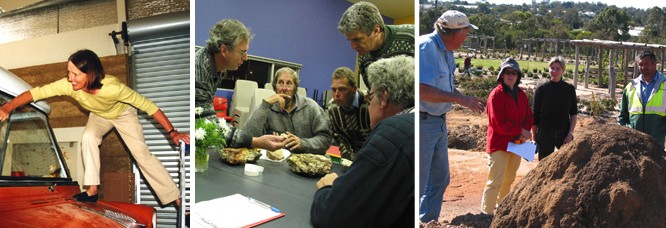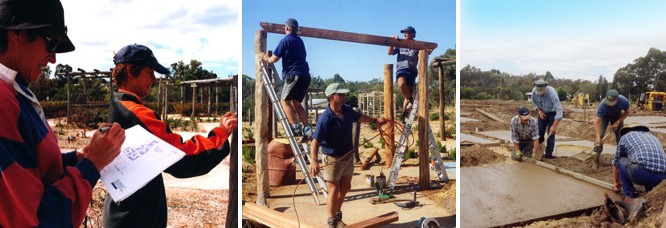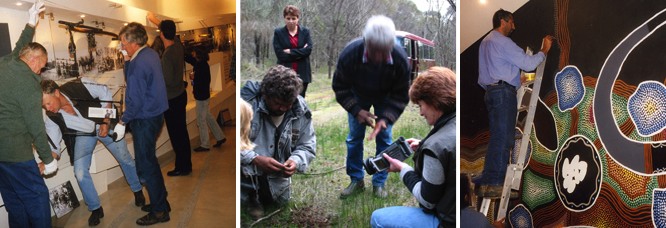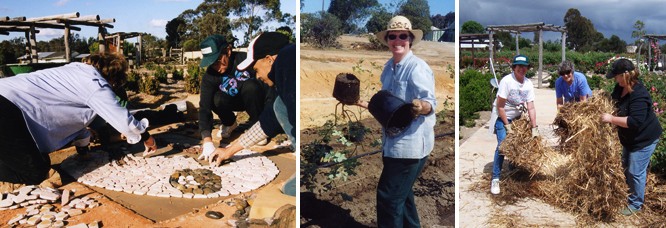
Lots of care and contemplation went into the development of every display: polishing the school bus, selecting local fossils, and deciding how to display a termite mound – without the termites! Photos: Penny Young.
How we did it: community driven!
Growth and collaboration
The creation of The Kodja Place by the Kojonup community was an extraordinary exercise in cross-cultural reconciliation and participation, planning, teamwork and lots of talking! Local skill development, community-led curating and locally-driven project management were other vital elements that inspired and enriched the project. Hundreds of local people helped, as well as people from outside the district.
Evolution
The project began with the idea of creating something of lasting importance to mark the turning of the century and the Centenary of Federation in 2001: an Aboriginal Cultural Heritage Centre, Historical Interpretive Centre and Regional Rose Garden.
Over a few years the shape of the project evolved. Two stories in two centres became one centre with intertwining stories – a collaborative effort by Kojonup’s Noongar-Indigenous and settler communities (see Our reconciliation experience). The Regional Rose Garden became an Australian Rose Maze, designed locally, planted with Australian-bred roses and beautifully woven with the stories of three women from three cultures.

A creative local community at work: positioning the Three Women’s Stories, building pergolas and laying the paths. Photos: left by Wendy Thorn; others by Dorothy Bignell.
Groundwork and teamwork
Laying the groundwork began in the mid-1990s. For five years the community and the Shire sourced funds, worked on building plans, and tapped local creativity and skills to develop display ideas, gather and create display content, construct and landscape.
In the Rose Maze alone, over 150 community members worked to a creative plan to lay the paths, build the pergolas and structures, plant, and now maintain 1400 roses. Other local people oversaw the construction and fitting-out of The Kodja Place building, and yet another team of enthusiastic volunteers and local tradespeople focused on creating the interpretive displays in the Kodj Gallery and Storyplace.
Somehow, miraculously, the people of Kojonup – townspeople, farmers, Noongars, Wadjelas, artists, tradespeople, gardeners, visionaries, photographers, thinkers, doers, troubleshooters, gurus of finance, tourism and technology, historians, journalists, organisers, the Shire and the advisory committee – made it happen! We had more than enough problems, worries and set-backs to overcome, but we got there.

All hands on deck to install the Kodj Gallery display; recording video stories for the Storyplace; and a local Noongar artist at work in the Kodj Gallery. Photos: left & right by Dorothy Bignell; middle by Penny Young.
Partnerships
There was another absolutely essential ingredient throughout the project’s development … we formed wonderful partnerships (and friendships) with many very talented and skilled people from other places who were generous with their time and expertise, including architects, landscape designers, graphic designers, museum advisors and curators, historians, writers, video producers, information technology prodigies, and rose growers. With their help and mentoring we were able to achieve our goals, including excellent contemporary design and the development of a range of local skills for the ongoing creation of The Kodja Place.
The Kojonup community effort continues, including the creation of the Bush Pockets, further development of the Bush Tucker Trail, and, following a remarkable, local fundraising initiative, the establishment of the Black Cockatoo Café. Now we are upgrading the multi-media in the Storyplace ready for new stories.
We set high standards for The Kodja Place and were delighted to receive the inaugural ‘Marvellous Regional Museums Award’ from ABC Radio National. View Awards
Come and see why they loved it!

Laying mosaics to tell part of Yoondi’s story in the Australian Rose Maze; 1400 roses to plant and then there’s the mulching! Photos: left by Wendy Thorn; middle by Dorothy Bignell; right The Kodja Place collection.